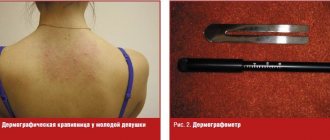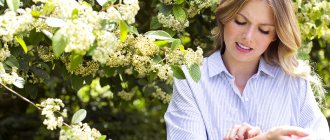Urticaria is a skin disease associated with the appearance of an allergic rash. In shape and size, it resembles the blisters that appear after being struck by nettles, hence the name. In the acute form, rashes appear literally in the first minutes after interaction with the provoking factor, they pass quickly - within a few hours. If the effect of the allergen is not eliminated, a recurrent form of the disease occurs. A single episode does not require treatment, but chronic urticaria will not go away without treatment. If you experience symptoms of hives, you should definitely consult a doctor.
At CELT you can get advice from a gastroenterologist.
- Initial consultation – 3,500
- Repeated consultation – 2,300
Make an appointment
Mechanism of disease development
Urticaria differs from other dermatological and allergic diseases in the presence of a clear and understandable relationship between exposure to an allergen and the appearance of rashes. Most often, patients can independently name the provoking agent - symptoms appear within a few minutes after contact with the provoking agent. If the causes of urticaria are unknown, then first of all it is recommended to pay attention to contact with animals and diet.
An immediate allergic reaction develops as follows: an allergen enters the body, mast cells are immediately sent to it - they cause the release of immunoglobulin E. When a mast cell is in conditions of increased immunoglobulin content, it produces histamines - substances that increase vascular permeability and cause swelling . This is a protective mechanism that allows the body to block part of the allergen, and remove part as quickly as possible.
The provoking factor may not be a substance, but a physical effect - heat or cold, stress. Allergies can also be caused by the presence of a source of infection in the human body.
In clinical diagnosis, acute and chronic forms of urticaria differ in duration - if episodes of urticaria are present for 6 weeks and are interspersed with periods of remission, then a diagnosis of chronic urticaria is made.
Therapy
The course of medications is prescribed only by a doctor. Self-medication when a rash occurs is unacceptable; it often becomes a threat to the patient and the people around him. Treatment for itchy blisters is aimed at eliminating the underlying cause, after which the rash begins to disappear.
It is forbidden to scratch the rash or intentionally open its elements; this sometimes leads to infection of the wounds. The bubbles should burst spontaneously.
Traditional medicine
If the rash is caused by viruses (herpes, chickenpox), antiviral drugs are used:
- Virolex;
- Acyclovir.
Antihistamines are prescribed to relieve itching:
- Claritin;
- Tavegil;
- Zyrtec;
- Suprastin.
Blisters are treated with antiseptics:
- brilliant green;
- Fukortsin;
- potassium permanganate solution.
Herpes on the lips can be treated with ointments:
- Penciclovir;
- Acyclovir.
To relieve fever, pain and inflammation use:
- Ibuprofen;
- Lidocaine gel;
- Paracetamol;
- Aspirin.
To treat contact dermatitis, use:
- antiallergenic agents (Claritin, Loratadine, Diazolin);
- corticosteroids (Sinaflan, Advantan, Dermovate, Lokoid);
- enterosorbents (Polysorb, activated carbon);
- immunomodulators (tincture of echinacea, ginseng, eleutherococcus);
- multivitamins (Alphabet, Vitrum).
Dyshidrosis is treated:
- corticosteroids (Hydrocortisone, Lorinden);
- antihistamines (Bepanten, Elokom, Advantan).
Fungal infections are treated with:
- local medications (Mikospor, Lotseril, Lamisil, Exoderil);
- antifungal drugs taken orally (Terbizil, Griseofulvin, Flucostat);
- sorbents (Enterosgel, Polysorb MP);
- immunomodulators (tincture of echinacea, ginseng, eleutherococcus).
Streptoderma is suppressed using:
- antiseptics for treating rashes (salicylic alcohol, brilliant green, Fukortsin);
- ointments with antibiotics (Triderm, Erythromycin ointment, Baneocin).
If a bacterial infection is added to the underlying cause of the rash with watery blisters, use:
- antibiotics (Augmentin, Amoxicillin, Erythromycin);
- immunomodulators (Immunal, Immunorm, echinacea extract, ginseng, eleutherococcus).
Folk remedies
Traditional medicine is added to complex treatment. Allergic reactions are relieved with herbal decoctions:
- Yarrow. Brew 1 tablespoon of the plant in 250 ml of boiled water. Let it brew for 1 hour. Drink 1 glass 3 times a day. The course of treatment is 21 days. The product successfully fights cold allergies.
- A series. In the evening, boil 1 liter of water, pour 4 tablespoons of the plant into the liquid, and leave until the morning. Take half a glass 3 times a day. Treatment lasts 21 days. The sequence is useful for food allergies.
Fungal infections are treated using the following:
- Strong coffee. The grains are ground in a coffee grinder, brew 5 teaspoons in 500 ml of boiling water, allow to cool to 37-40 C. Take 15-minute baths, immersing your hands or feet in the healing solution.
- Tea tree oil. The affected areas are treated with oil 3 times a day. The product is applied with a cotton pad. The skin stops peeling and itching, the blisters dry out and heal.
Baths and lotions with oak bark help cure dyshidrosis and prickly heat:
- For 2 liters of boiling water, take 8 tablespoons of plant material. The solution is cooled to 37-40 C, and baths are taken. The duration of the procedure is 15-20 minutes.
- Brew 1 teaspoon of bark in 250 ml of boiling water. When the infusion has cooled to a comfortable temperature, moisten a napkin in it and apply it to the affected area. Leave the application until it dries.
With the correct diagnosis and timely treatment, itchy blisters heal quickly without causing complications.
Causes of development and forms of urticaria
The main cause of hives is contact with an allergen. There are many factors that can provoke a pathological response of the immune system (this is an allergy). Most often, urticaria is caused by contact with such groups of substances as:
- Medicines, especially antibiotics and hormonal drugs.
- Dust.
- Animal fur or feathers.
- Plant pollen, poplar fluff.
- Substances that get under the skin from insect bites.
- Compounds that parasites secrete are most often caused by Giardia.
- Some substances contained in food products.
For the development of acute urticaria, short-term contact with the allergen is sufficient. The chronic form is characterized by frequent relapses and is associated with prolonged proximity to the substance causing the pathological reaction. Therefore, at the first manifestations of an allergy, it makes sense to conduct special tests, find out what exactly caused the rash, and exclude any contact with this substance.
In the chronic form, the rash and inflammation are less pronounced. After an exacerbation, the symptoms disappear for a while. Recurrent urticaria may be associated with the presence of a source of infection in the body and requires consultation with a specialist.
Therapy
The course of medications is prescribed only by a doctor. Self-medication when a rash occurs is unacceptable; it often becomes a threat to the patient and the people around him. Treatment for itchy blisters is aimed at eliminating the underlying cause, after which the rash begins to disappear.
It is forbidden to scratch the rash or intentionally open its elements; this sometimes leads to infection of the wounds. The bubbles should burst spontaneously.
Traditional medicine
If the rash is caused by viruses (herpes, chickenpox), antiviral drugs are used:
Antihistamines are prescribed to relieve itching:
Blisters are treated with antiseptics:
- brilliant green;
- Fukortsin;
- potassium permanganate solution.
Herpes on the lips can be treated with ointments:
To relieve fever, pain and inflammation use:
To treat contact dermatitis, use:
- antiallergenic agents (Claritin, Loratadine, Diazolin);
- corticosteroids (Sinaflan, Advantan, Dermovate, Lokoid);
- enterosorbents (Polysorb, activated carbon);
- immunomodulators (tincture of echinacea, ginseng, eleutherococcus);
- multivitamins (Alphabet, Vitrum).
- corticosteroids (Hydrocortisone, Lorinden);
- antihistamines (Bepanten, Elokom, Advantan).
Fungal infections are treated with:
- local medications (Mikospor, Lotseril, Lamisil, Exoderil);
- antifungal drugs taken orally (Terbizil, Griseofulvin, Flucostat);
- sorbents (Enterosgel, Polysorb MP);
- immunomodulators (tincture of echinacea, ginseng, eleutherococcus).
Streptoderma is suppressed using:
- antiseptics for treating rashes (salicylic alcohol, brilliant green, Fukortsin);
- ointments with antibiotics (Triderm, Erythromycin ointment, Baneocin).
If a bacterial infection is added to the underlying cause of the rash with watery blisters, use:
- antibiotics (Augmentin, Amoxicillin, Erythromycin);
- immunomodulators (Immunal, Immunorm, echinacea extract, ginseng, eleutherococcus).
Folk remedies
Traditional medicine is added to complex treatment. Allergic reactions are relieved with herbal decoctions:
- Yarrow. Brew 1 tablespoon of the plant in 250 ml of boiled water. Let it brew for 1 hour. Drink 1 glass 3 times a day. The course of treatment is 21 days. The product successfully fights cold allergies.
- A series. In the evening, boil 1 liter of water, pour 4 tablespoons of the plant into the liquid, and leave until the morning. Take half a glass 3 times a day. Treatment lasts 21 days. The sequence is useful for food allergies.
Fungal infections are treated using the following:
- Strong coffee. The grains are ground in a coffee grinder, brew 5 teaspoons in 500 ml of boiling water, allow to cool to 37-40 0 C. Take 15-minute baths, immersing your hands or feet in the healing solution.
- Tea tree oil. The affected areas are treated with oil 3 times a day. The product is applied with a cotton pad. The skin stops peeling and itching, the blisters dry out and heal.
Baths and lotions with oak bark help cure dyshidrosis and prickly heat:
- For 2 liters of boiling water, take 8 tablespoons of plant material. The solution is cooled to 37-40 0 C, and baths are taken. The duration of the procedure is 15-20 minutes.
- Brew 1 teaspoon of bark in 250 ml of boiling water. When the infusion has cooled to a comfortable temperature, moisten a napkin in it and apply it to the affected area. Leave the application until it dries.
With the correct diagnosis and timely treatment, itchy blisters heal quickly without causing complications.
Every person who is faced with the problem of a skin disease, like no one else, can tell you what unpleasant sensations itching and burning of the skin causes.
When this kind of discomfort occurs, you want to find out the causes of any formations on the skin as soon as possible in order to quickly eliminate them.
Most often, the body becomes blistered and itchy.
Such formation interferes with a person’s normal life activities, since the blister itches. What is the reason for their appearance and methods of treatment - we will talk about this in our article.
Symptoms of urticaria
The disease has specific manifestations, so there are usually no problems with making a diagnosis.
Specific symptoms of allergic urticaria:
- Skin rashes resembling blisters from contact with nettles.
- When pressed, the blisters are white and lose color.
- Itching that leads to scratching.
- The skin at the site of the lesion is swollen and red.
- The rash can appear on any part of the body in its acute form; sometimes urticaria even affects the mucous membranes.
- In chronic pathology, the rash often appears on the bends of the arms and legs.
With direct contact with the allergen, rashes appear quickly, within a few minutes, and disappear without a trace in a maximum of 2 days. The rash subsides within 3-6 hours.
If complications develop, skin symptoms may be accompanied by swelling of the larynx, fever, weakness, headache, nausea, and difficulty breathing.
If life-threatening complications occur, you must take any antihistamine and call a doctor. If allergy symptoms only include hives, then emergency care is not required. In this case, it is worth making an appointment with an allergist to establish a diagnosis and avoid chronicity of the disease.
Price
Allergology-immunology
| Name of service | Price |
| Consultation with an allergist-immunologist, primary | 3 500 ₽ |
Advantages
- The latest, constantly updated equipment
- Interest-free installments for all services
- Online consultations with an ENT doctor
- Visit of an ENT doctor to your home
- Friendly and qualified staff
- 24/7 ENT assistance
Hives are a condition characterized by a reddish, itchy rash on the skin that is caused by an allergic reaction. It is not contagious and is most often caused by a specific allergen, but in some cases the cause is unknown.
An allergic reaction to hives is fraught with serious complications that require urgent medical attention and are life-threatening. Therefore, you should not endure unpleasant attacks, but contact an allergist and find out how to treat urticaria in your particular case.
Diagnosis of urticaria
Diagnosis begins with an examination by a medical specialist and most often ends at the stage of collecting an anamnesis. Typical urticaria is associated with the presence of a specific allergen. Most patients had atopic reactions in childhood. Visual assessment of the skin helps to make a final diagnosis - urticaria can be easily distinguished from other skin diseases.
If there are symptoms, but the patient finds it difficult to name the reason for the development of the pathological reaction, a number of specific tests are performed. Laboratory tests include determination of general and specific immunoglobulin E, as well as a general blood test. Special provocative tests allow you to identify a fairly specific allergy provocateur. If the cause is not established, further diagnosis involves testing for parasitic infestations.
Our doctors
Orlova Tatyana Vladimirovna
Doctor - allergist-immunologist, pulmonologist, doctor of the highest category
Experience 38 years
Make an appointment
Shundeva Oksana Veniaminovna
Allergist, doctor of the highest category
Experience 39 years
Make an appointment
Treatment of the disease
If the allergen is known, then the main recommendation is to avoid, if possible, contact with the substance that provokes hives. That is why accurate diagnosis is important - it is necessary to understand which group of chemical compounds can lead to the development of urticaria. It often happens that the same substance is found in different foods or in different pharmaceuticals. And an allergy to pets can affect only one breed or spread to almost all pets, from cats to hamsters.
Therapy is needed if the disease has become a recurrent form - this happens if it is impossible to stop contact with the provocateur. In a situation where test results show the presence of an infectious focus, it is necessary to determine the infectious disease. It is likely that the urticaria will go away after healing.
If a patient is diagnosed with an allergy to dust, food or plants, then lifestyle changes are required: frequent wet cleaning, following a proper diet and avoiding walking during the flowering period of plants. Concomitant treatment is designed to alleviate symptoms when they reappear.
Classification
Types of non-acantholytic pemphigus:
- Non-acantholytic pemphigus is benign. Pathological elements are formed exclusively in the human oral cavity. Upon examination, inflammation of the mucous membrane, as well as its slight ulceration, can be detected.
- Bullous form of non-acantholytic pemphigus. This is a benign disease that develops in both adults and children. Blisters form on the skin, but there are no signs of acantholysis. These pathological elements can spontaneously disappear without scarring.
- Cicatricial non-acantholytic pemphigus. This pemphigoid is called pemphigus of the eye in the medical literature. Most often it is diagnosed in women who have crossed the 45-year age limit. A characteristic symptom is damage to the visual apparatus, skin and oral mucosa.
Classification of true pemphigus:
- Erythematous form. This pathological process combines several diseases. Its symptoms are similar to seborrheic dermatitis, an erythematous variant of systemic lupus, as well as true pemphigus. Erythematous pemphigus in adults and children is very difficult to treat. It is worth noting that the disease is diagnosed not only in people, but also in some animals. A characteristic symptom is the appearance of red spots on the skin of the body and face, covered with crusts on top. Simultaneously with this symptom, seborrheic manifestations appear on the scalp.
- Pemphigus vulgare. This type of pathology is diagnosed in patients more often. Blisters form on the skin, but there are no signs of inflammation. If pemphigus is not treated on time, pathological elements can spread throughout the entire skin. It is worth noting that they can merge and form large lesions.
- Pemphigus foliaceus. This form received its name due to the characteristics of the pathological elements. Blisters form on the human skin, which practically do not rise above the epidermis (not tense). Crusts form on top of them, which tend to layer on top of each other. The effect of sheet material folded in stacks is created.
- Brazilian pemphigus. There are no restrictions regarding gender and age. Cases of its development have been recorded in both young children and elderly people aged 70 to 80 years. It is also possible that it may progress in middle-aged people. It is worth noting that this variety is endemic and is therefore found only in Brazil.






